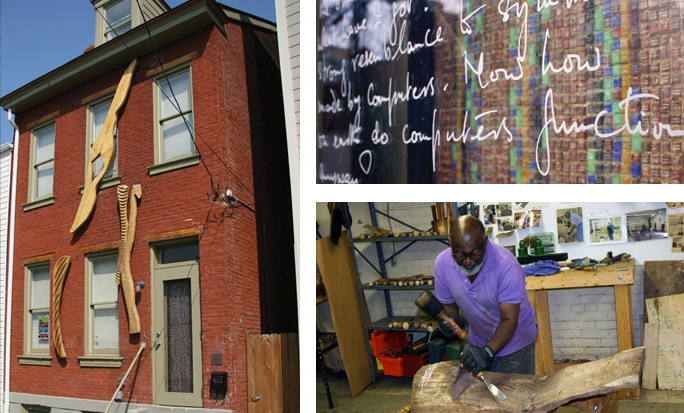Winged House is based on a passage from The Man Died, a memoir of Nigerian author Wole Soyinka. The passage describes one of the ways Mr. Soyinka kept his mind sharp while imprisoned in solitary confinement. Mr. Soyinka is a co-founder of Cities of Asylum and is also a winner of the Nobel Prize in Literature.
Winged House is a multi-faceted artistic collaboration, involving several artists and media. The core of Winged House is the text by Mr. Soyinka. For Winged House, Mr. Soyinka wrote out the text in his own handwriting, and it was then blown up and sandblasted into the glass of the storm door. Behind the storm door is a glass-tile mosaic, arranging all 720 combinations of six colors. The mosaic was a collaboration between the Mattress Factory’s Community Art Lab and artists Laura Jean McLaughlin and Bob Ziller. Soaring over the façade is a commissioned sculpture, “Spiritual Wings,” by Thaddeus Mosley, made in response to Mr. Soyinka’s text. Technical assistance was provided by Adena Construction Company.
Winged House is the second house that City of Asylum has rehabbed as a safe home for exiled writers, and the second publication in its public library project. It was dedicated by Mr. Soyinka at City of Asylum’s annual Jazz-Poetry Concert on September 9, 2006.
Text in the door of Winged House:
“I had newly discovered the world of numbers. Once the first breakthrough was over I began with increasing rapidity to rediscover one mathematical formula after another. Part investigation, part titanic excavation from the murky burial-ground of the labours of long-suffering teachers I tackled one idea after another, testing and re-testing the achieved formula by the most simplistic count-by-count systems. I had TIME! Often I woke up in the morning to a problem and one minute later literally one minute later the guard was tapping on the door to signal lock-up hour. I DESTROYED time. Once I wrote out all the possible combinations of six digits. In the process I uncovered the only way that this could be done to ensure, at a glance, that there was neither duplication nor omission. The result was so obviously a plan for computed aesthetics that I ruled out squares on toilet paper and proceeded to repeat those combinations with colored squares.(Green from leaf juice, black from my ink — christened Soy-ink — and toilet paper white.) The cyclic continuum of the result next made an impression. I joined one end of the toilet paper to the other and asked, Now what have I got? It had a strong resemblance to symbols made by computers. Now how on earth do computers function anyway?”
—Wole Soyinka, The Man Died


